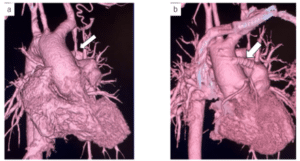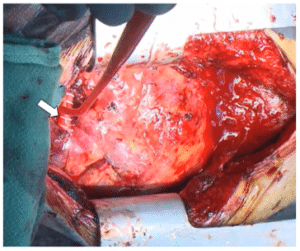Keisuke Nakanishi1*, Shiori Kawasaki1, Atsushi Amano1, Minoru Tabata1
1Department of Cardiovascular Surgery, Juntendo University, School of Medicine, Tokyo, Japan
*Correspondence author: Keisuke Nakanishi, MD, Associate Professor, Department of Cardiovascular Surgery, Juntendo University, School of Medicine, Tokyo, Japan; Email: [email protected]
Published On: 30-04-2023
Copyright© 2023 by Nakanishi K, et al. All rights reserved. This is an open access article distributed under the terms of the Creative Commons Attribution License, which permits unrestricted use, distribution and reproduction in any medium, provided the original author and source are credited.
Abstract
The Blalock-Taussig (BT) shunt was first used to treat the tetralogy of Fallot in 1946. Since then, it has undergone improvements to create a short circuit in the pulmonary artery using an artificial blood vessel. The prognosis after palliative surgery alone is poor; hence, there is a need for radical surgery to improve the long-term prognosis. However, for various reasons, some patients have undergone the Blalock surgery alone without any other therapeutic interventions. In this report, we describe a case of a central shunt surgery performed to improve cyanosis in a patient who had been followed up for a long time without radical surgery after receiving an original BT shunt.
Keywords: Tetralogy of Fallot; Original Blalock-Taussig Shunt; Congenital Heart Surgery
Abbreviations
BT: Blalock-Taussig; CT: Computed Tomography
Case Examination
The patient was a 34-year-old woman (weight, 38.3 kg; height, 150 cm; BSA, 1.29) who had been diagnosed with the tetralogy of Fallot at birth based on severe cyanosis. The original m-BT shunt on the left was placed at the age of 2 years during outpatient follow-up, the patient fell down the stairs and suffered a cervical spinal injury [1,2]. This severely reduced the patient’s physical ability and her parents chose not to pursue a radical surgery. Despite concerns about the patient developing pulmonary arterial hypertension due to a high blood-flow pulmonary injury, this decision was respected because the patient’s exercise capacity had declined significantly to the point where she could not tolerate such an invasive procedure. Cyanosis had progressed rapidly and the minimum saturation level was reduced to approximately 50% during physical movement; thus, we decided to treat her surgically.
Differential Diagnosis, Investigation and Treatment
The patient’s physical activities of daily living had decreased significantly. Due to suspected pulmonary artery hypoplasia, radical surgery was not indicated for the patient. Preoperative contrast-enhanced Computed Tomography (CT) revealed stenosis of the subclavian artery at its anastomosis to the pulmonary artery and complete occlusion of the right ventricular outflow tract (Fig. 1). Preoperative echocardiography revealed normal functioning of the left ventricle (ejection fraction: 63%). Due to normal valvular function, the right ventricular pressure could not be predicted accurately. During surgery, dissection was performed through the conventional midline incision approach. After establishing an artificial heart-lung machine with an ascending aortic blood supply and right atrial debridement, a short circuit was created from the ascending aorta to the main pulmonary artery using a 6 mm artificial vessel (Fig. 2). The patient was easily weaned off the cardiopulmonary bypass and the course of postoperative intensive care unit management was good. The patient was weaned off the ventilator on the first postoperative day and subsequent rehabilitation progressed smoothly despite paralysis.

Figure 1: A: Subclavian artery stenosis at the anastomosis to the pulmonary artery (white arrow) and complete occlusion of the right ventricular outflow tract. B: The central shunt (white arrow) and pulmonary artery were preserved by blood flow from the shunt.

Figure 2: A systemic pulmonary shunt (white arrow) was created from the ascending aorta to the main pulmonary artery using a 6 mm artificial vessel.
Outcome and Follow-up
The SpO2 increased from 50% to 80% postoperatively and the preoperative symptoms (such as a fall in the SpO2 on light exertion) improved. Postoperative contrast-enhanced CT showed that blood flow to the shunt and pulmonary artery was maintained (Fig. 1). Immediately after the surgery, mild pulmonary congestion findings were noted, which gradually improved over the next week. Postoperative echocardiographic findings also revealed a normal cardiac function, suggesting that the shunt surgery did not cause cardiac failure due to a high pulmonary blood flow.
Ethics and Consent to Participate
The study was approved by the ethics review board of our institution and the patient provided written informed consent for the publication of this case.
Discussion
The BT shunt was originally designed and used to improve cyanosis in patients with the tetralogy of Fallot; however, it is not curative and the pulmonary artery blood flow rate decreases with physical growth. The 25-year survival rate of patients with the tetralogy of Fallot who undergo palliative surgery alone is approximately 50% [3]. Case reports on central palliative shunting in adulthood are rare; we have reported a case wherein cyanosis improved in adulthood after central shunting [4,5].
The development of postoperative congestive heart failure and hypercapnic lung injury were the main concerns in this case [6]. Shunting reduces the blood flow to the body and increases pulmonary blood flow, thereby increasing Qp/Qs during the surgical procedure. It may be difficult to preoperatively and accurately evaluate whether the patient’s heart tolerates congestive heart failure. The 6 mm artificial vessel used in this case prevented a low-blood-flow-related progression to heart failure, although the lungs showed temporary damage postoperatively due to the high pulmonary blood flow.
The patency of artificial blood vessels is another concern in such cases. Even though there are many reports on the patency of artificial vessels in femoral popliteal bypass there are no reports on the patency of central shunts in adult patients [7,8]. The shorter distance of the artificial vessel and its higher blood flow rate in this procedure are expected to result in a patency rate higher than that observed in femoral popliteal bypass; however, this has not been confirmed with clarity.
Conclusion
In summary, we performed central shunting in a 34-year-old woman who was diagnosed with the tetralogy of Fallot with progressive cyanosis. The 6 mm artificial vessel used in this study did not cause heart failure, although the postoperative lungs were temporarily damaged due to an increased pulmonary blood flow. Central shunting was effective in improving the SpO2 in this patient; however, there are several uncertainties regarding the postoperative hemodynamics.
Funding
This research received no specific grants from any funding agency or commercial and not-for-profit sectors.
Authors’ Contributions
Conception and design of the study: KN and SK
Drafting of the manuscript: KN
Critical revision of the manuscript for important intellectual content: KN, SK and AA
Approval of the final version of the manuscript to be published: AA and MT
Conflict of Interest
The authors have no conflict of interest to declare.
References
- Blalock A. The surgical treatment of congenital pulmonic stenosis. Ann Surg. 1946;124(5):879-85.
- de Leval MR, McKay R, Jones M, Stark J, Macartney FJ. Modified Blalock-Taussig shunt. Use of subclavian artery orifice as flow regulator in prosthetic systemic-pulmonary artery shunts. J Thorac Cardiovasc Surg. 1981;81(1):112-9.
- Presbitero P, D’Antonio P, Brusca A, Morea M. Prognosis of Fallot’s tetralogy after palliative operations: 10–25-year follow-up. Pediatr Cardiol. 1983;4(3):175-82.
- Peries A, Al-Hay AA, Shinebourne EA. Outcome of the construction of a Blalock-Taussig shunt in adolescents and adults. Cardiol Young. 2005;15(4):368-72.
- Zhang H, Fan X, Su J, Liu Y, Zhao L, Li G. The efficiency of systemic-to-pulmonary shunts in older children with hypoplastic pulmonary arteries. J Card Surg. 2019;34(6):463-7.
- Yang J, He BC, Chen JM. Results of surgery on adults with functional single ventricle without prior cardiac surgery in childhood. J Card Surg. 2019;34(12):1556-62.
- Lumsden AB, Morrissey NJ. Comparison of safety and primary patency between the fusion bioline heparin-coated vascular graft and exxcel soft ePTFE (FINEST) Trial Co-investigators. Randomized controlled trial comparing the safety and efficacy between the FUSION BIOLINE heparin-coated vascular graft and the standard expanded polytetrafluoroethylene graft for femoropopliteal bypass. J Vasc Surg. 2015;61(3):703-12.
- Klinkert P, Post PN, Breslau PJ, van Bockel JH. Saphenous vein versus PTFE for above-knee femoropopliteal bypass. A review of the literature. Eur J Vasc Endovasc Surg. 2004;27(4):357-62.
Article Type
Case Report
Publication History
Received On: 06-04-2023
Accepted On: 24-04-2023
Published On: 30-04-2023
Copyright© 2023 by Nakanishi K, et al. All rights reserved. This is an open access article distributed under the terms of the Creative Commons Attribution License, which permits unrestricted use, distribution, and reproduction in any medium, provided the original author and source are credited.
Citation: Nakanishi K, et al. Central Shunting for Tetralogy of Fallot After Original Blalock-Taussig Shunt in a 34-Year-Old Woman. J Surg Res Prac. 2023;4(1):1-4.

Figure 1: A: Subclavian artery stenosis at the anastomosis to the pulmonary artery (white arrow) and complete occlusion of the right ventricular outflow tract. B: The central shunt (white arrow) and pulmonary artery were preserved by blood flow from the shunt.

Figure 2: A systemic pulmonary shunt (white arrow) was created from the ascending aorta to the main pulmonary artery using a 6 mm artificial vessel.


